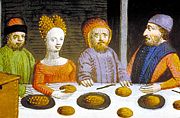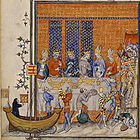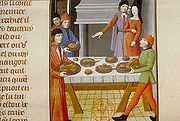
Entremet
Encyclopedia

French cuisine
French cuisine is a style of food preparation originating from France that has developed from centuries of social change. In the Middle Ages, Guillaume Tirel , a court chef, authored Le Viandier, one of the earliest recipe collections of Medieval France...
a small dish served between courses or simply a dessert. Originally it was an elaborate form of entertainment dish common among the nobility and upper middle class in Western Europe during the later part of the Middle Ages
Middle Ages
The Middle Ages is a periodization of European history from the 5th century to the 15th century. The Middle Ages follows the fall of the Western Roman Empire in 476 and precedes the Early Modern Era. It is the middle period of a three-period division of Western history: Classic, Medieval and Modern...
and the early modern period
Early modern period
In history, the early modern period of modern history follows the late Middle Ages. Although the chronological limits of the period are open to debate, the timeframe spans the period after the late portion of the Middle Ages through the beginning of the Age of Revolutions...
. An entremet marked the end of a serving of courses and could be anything from a simple frumenty
Frumenty
Frumenty was a popular dish in Western European medieval cuisine. It was made primarily from boiled, cracked wheat - hence its name, which derives from the Latin word frumentum, "grain". Different recipes added milk, eggs or broth. Other recipes include almonds, currants, sugar, saffron and...
(a type of wheat porridge
Porridge
Porridge is a dish made by boiling oats or other cereal meals in water, milk, or both. It is usually served hot in a bowl or dish...
) that was brightly colored and flavored with exotic and expensive spice
Spice
A spice is a dried seed, fruit, root, bark, or vegetative substance used in nutritionally insignificant quantities as a food additive for flavor, color, or as a preservative that kills harmful bacteria or prevents their growth. It may be used to flavour a dish or to hide other flavours...
s to elaborate models of castles complete with wine fountains, musicians, and food modeled into allegorical scenes. By end of the Middle Ages, it had evolved almost entirely into dinner entertainment in the form of inedible ornaments or acted performances, often packed with symbolism of power and regality. In English it was more commonly known as a subtlety (also sotelty or soteltie) and did not include acted entertainment.
History

Roman Empire
The Roman Empire was the post-Republican period of the ancient Roman civilization, characterised by an autocratic form of government and large territorial holdings in Europe and around the Mediterranean....
. In his Satyricon
Satyricon
Satyricon is a Latin work of fiction in a mixture of prose and poetry. It is believed to have been written by Gaius Petronius, though the manuscript tradition identifies the author as a certain Titus Petronius...
the Roman writer Petronius
Petronius
Gaius Petronius Arbiter was a Roman courtier during the reign of Nero. He is generally believed to be the author of the Satyricon, a satirical novel believed to have been written during the Neronian age.-Life:...
describes a dish consisting of a rabbit
Rabbit
Rabbits are small mammals in the family Leporidae of the order Lagomorpha, found in several parts of the world...
dressed up to look like the mythical horse Pegasus
Pegasus
Pegasus is one of the best known fantastical as well as mythological creatures in Greek mythology. He is a winged divine horse, usually white in color. He was sired by Poseidon, in his role as horse-god, and foaled by the Gorgon Medusa. He was the brother of Chrysaor, born at a single birthing...
. The function of the entremet was to mark the end of a course, met, a serving of several dishes, of which there were could be several at a banquet. It punctuated each stage of a banquet, prepared the diners for the next one serving and served as a conversation piece. The earliest recipe for an entremet can be found in an edition of Le Viandier
Viandier
Le Viandier is a recipe collection largely credited to Guillaume Tirel, alias Taillevent. However, the earliest version of the book has been dated to around 1300, about 10 years before the birth of Tirel...
, a medieval recipe collection, from the early 14th century. It described a comparatively simple dish; boiled and fried chicken liver with chopped giblet with ground ginger, cinnamon, cloves, wine, verjuice
Verjuice
Verjuice is a very acidic juice made by pressing unripe grapes, crab-apples or other sour fruit. Sometimes lemon or sorrel juice, herbs or spices are added to change the flavour. In the Middle Ages, it was widely used all over Western Europe as an ingredient in sauces, as a condiment, or to...
, beef bouillon and egg yolks served with cinnamon on top, and was supposed to be of a bright yellow color. An even simpler dish, like millet
Millet
The millets are a group of small-seeded species of cereal crops or grains, widely grown around the world for food and fodder. They do not form a taxonomic group, but rather a functional or agronomic one. Their essential similarities are that they are small-seeded grasses grown in difficult...
boiled in milk and seasoned with saffron, was also considered to be an entremet. The most noticeable trait of the early entremets was the focus on vivid colors. Later on the entremets would take the shape of various types of illusion foods, such as peacocks
Peafowl
Peafowl are two Asiatic species of flying birds in the genus Pavo of the pheasant family, Phasianidae, best known for the male's extravagant eye-spotted tail, which it displays as part of courtship. The male is called a peacock, the female a peahen, and the offspring peachicks. The adult female...
or swan
Swan
Swans, genus Cygnus, are birds of the family Anatidae, which also includes geese and ducks. Swans are grouped with the closely related geese in the subfamily Anserinae where they form the tribe Cygnini. Sometimes, they are considered a distinct subfamily, Cygninae...
s that were skinned, cooked, seasoned and then redressed in their original plumage (or filled with the meat of tastier fowl) or even scenes depicting contemporary human activities, such as a knight
Knight
A knight was a member of a class of lower nobility in the High Middle Ages.By the Late Middle Ages, the rank had become associated with the ideals of chivalry, a code of conduct for the perfect courtly Christian warrior....
in the form of a grilled capon
Capon
A capon is a rooster that has been castrated to improve the quality of its flesh for food.-History:The Romans are credited with inventing the capon. The Lex Faunia of 162 BC forbade fattening hens in order to conserve grain rations. In order to get around this the Romans castrated roosters, which...
equipped with a paper helmet and lance, sitting on the back of a roast piglet. Elaborate models of castles made from edible material was a popular theme. At a feast dedicated to Pope Clement VI
Pope Clement VI
Pope Clement VI , bornPierre Roger, the fourth of the Avignon Popes, was pope from May 1342 until his death in December of 1352...
, one of the Avignon popes
Avignon Papacy
The Avignon Papacy was the period from 1309 to 1376 during which seven Popes resided in Avignon, in modern-day France. This arose from the conflict between the Papacy and the French crown....
, in 1343, one of the entremets was a castle with walls made from roast birds, populated with cooked and redressed deer, wild boar, goat, hare and rabbit.
In the 14th century entremets began to involve not just eye-catching displays of amusing haute cuisine
Haute cuisine
Haute cuisine or grande cuisine was characterised by French cuisine in elaborate preparations and presentations served in small and numerous courses that were produced by large and hierarchical staffs at the grand restaurants and hotels of Europe.The 17th century chef and writer La Varenne...
, but also more prominent and often highly symbolic forms of inedible entertainment. In 1306, the knighting of the son of Edward I
Edward I of England
Edward I , also known as Edward Longshanks and the Hammer of the Scots, was King of England from 1272 to 1307. The first son of Henry III, Edward was involved early in the political intrigues of his father's reign, which included an outright rebellion by the English barons...
included performances of chanson de geste
Chanson de geste
The chansons de geste, Old French for "songs of heroic deeds", are the epic poems that appear at the dawn of French literature. The earliest known examples date from the late eleventh and early twelfth centuries, nearly a hundred years before the emergence of the lyric poetry of the trouvères and...
in what has been assumed to be part of the entremets. During the course of the 14th century they would often take on the character of theatrical displays, complete with props, actors, singers, mummers and dancers. At a banquet held by Charles V
Charles V of France
Charles V , called the Wise, was King of France from 1364 to his death in 1380 and a member of the House of Valois...
in honor of Emperor Charles IV
Charles IV, Holy Roman Emperor
Charles IV , born Wenceslaus , was the second king of Bohemia from the House of Luxembourg, and the first king of Bohemia to also become Holy Roman Emperor....
in 1378, a huge wooden model of the city of Jerusalem was rolled in before the high table. Actors portraying the crusader Godfrey of Bouillon
Godfrey of Bouillon
Godfrey of Bouillon was a medieval Frankish knight who was one of the leaders of the First Crusade from 1096 until his death. He was the Lord of Bouillon, from which he took his byname, from 1076 and the Duke of Lower Lorraine from 1087...
and his knights then sailed into the hall on a miniature ship and reenacted the capture of Jerusalem
Siege of Jerusalem (1099)
The Siege of Jerusalem took place from June 7 to July 15, 1099 during the First Crusade. The Crusaders stormed and captured the city from Fatimid Egypt.-Background:...
in 1099. In late medieval and early modern England, entremets are referred to as subtleties from the late 14th century and onwards. The English term was derived from an older meaning of the word "subtle" with the meaning "clever" or "surprising". The English term did not include entertainment involving actors and these were referred to as pageants. The “four and twenty blackbirds baked in a pie,” has its genesis in a entremet presented to amuse banquet guests in the 14th century. This extravaganza of hospitality was detailed by an Italian cook of the era. “Live birds were slipped into a baked pie shell through a hole cut in its bottom.” The unwary guest would release the flapping birds once the upper crust was cut into.

Boar
Wild boar, also wild pig, is a species of the pig genus Sus, part of the biological family Suidae. The species includes many subspecies. It is the wild ancestor of the domestic pig, an animal with which it freely hybridises...
's head and a pike cooked and sauced in three different ways without having been cut into pieces, all of them breathing fire. The battlements of the castle were adorned with the banners of the Duke and his guests, manned by miniature archers, and inside the castle there was a fountain that gushed rosewater and spiced wine.Noteworthy for its entertainment value to the assembled nobles of the time, the 17th century provided a memorable banquet event courtesy of the host, the Duke of Buckingham. In honor of his royal guests, Charles I and Queen Henrietta Maria, a pie was prepared its interior concealing a human being, a famous dwarf of the era, one Jeffrey Hudson.
Entremets also made an effective tool for political displays. One of the most famous examples is the so-called Feast of the Pheasant
Feast of the Pheasant
The Feast of the Pheasant was a banquet given by Philip the Good, Duke of Burgundy on 17 February 1454 in Lille, now in France. Its purpose was to promote a crusade against the Turks, who had taken Constantinople the year before...
, arranged by Philip the Good of Burgundy
Duchy of Burgundy
The Duchy of Burgundy , was heir to an ancient and prestigious reputation and a large division of the lands of the Second Kingdom of Burgundy and in its own right was one of the geographically larger ducal territories in the emergence of Early Modern Europe from Medieval Europe.Even in that...
in 1454. The theme of the banquet was the fall of Constantinople
Fall of Constantinople
The Fall of Constantinople was the capture of the capital of the Byzantine Empire, which occurred after a siege by the Ottoman Empire, under the command of Ottoman Sultan Mehmed II, against the defending army commanded by Byzantine Emperor Constantine XI...
to the Ottoman Turks in 1453, and included a vow by Philip and his guests to retake the city in a crusade, though this was never actually realized. There were several spectacular displays at the banquet referred to by contemporary witnesses as entremets. Guests were entertained by a wide extravagant displays in the form of automaton
Automaton
An automaton is a self-operating machine. The word is sometimes used to describe a robot, more specifically an autonomous robot. An alternative spelling, now obsolete, is automation.-Etymology:...
s in the form of fountains and pies containing musicians. At the end of the banquet, an actor representing the Holy Church rode in on an elephant and read a poem about the plight of Eastern Christianity under Ottoman rule.
For modern pastry chefs, Entremet typically refers to a multi-layered mousse-based cake with various complementary flavors and varying textural contrasts.
External links
- How to Cook Medieval - A guide on how to make medieval cuisine and subtleties with modern ingredients
- Wikibooks Cookbook

